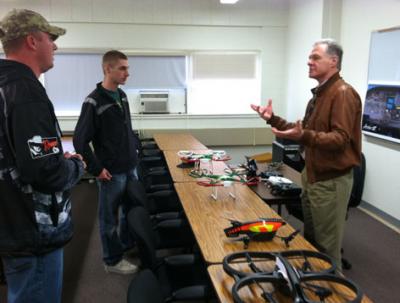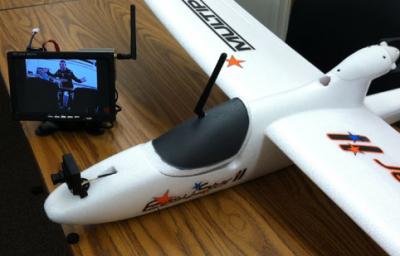Drones Over Montana: Interview with Professor Scott Wilson
Unmanned Aerial Systems
Unmanned Aerial Systems Interview with Professor Scott Wilson, Rocky Mountain College Aviation Program
So let’s start with the word “drone.” In the minds of most people there is likely an instant connection with “military” or “spying.” Do you object to the use of that word?
I understand why the media uses the word “drone” because it is much shorter and more understandable to the general public than “Unmanned Aircraft Systems.” I am also comfortable with the term because I served 32 years as an officer in the Navy, where “drone” is commonly used.
You have been quoted as saying that “the last fighter pilot has already been born.” What do you mean by that?
As America’s technological prowess grows, America’s tolerance for wartime losses is diminishing. Fighter drones can fill the gap. In the rough and tumble maneuvers of dogfights, UAS can sustain much higher G-loads and roll rates than manned fighter aircraft. Without a vulnerable human pilot aboard, they may also sustain more battle damage. Furthermore, the weight added to current fighters due to crew life support systems and ejection seats can total thousands of pounds, but 100% of a UAS can be dedicated as a weapons platform. Small UAS can also be programmed for swarming “kamikaze” attacks on enemy targets and aircraft.

In 2014, I am confident that fighter pilots can react and analyze air-to-air combat situations faster than UAS, but with rate of drone development, I do not think that will still be the case in 2024. Killer drones already exist. America is currently leading the world in UAS development, but other nations, some of which are hostile to American interests, are also developing UAS. As we look at all the armed conflict spots around the world, I believe the day will soon come when drones will attack drones.
UAS is getting big. There is now even a UAV Pilot Training certificate available. Is this what you envision for RMC?
The vision has already become reality at Rocky Mountain College. I give the students more than just a certificate by endorsing the permanent logbooks of students who demonstrate UAS expertise.
Tell us about the UAS course you are developing for RMC. What will it cover?
The UAS course provides an overview of Unmanned Aircraft System operations from a non-engineering civilian operational perspective. The course covers the history of UAS, then explores current technology and potential UAS developments in the future. The course also examines all facets of UAS operations, including safety procedures and relevant human factors.

Will the UAS course evolve to a separate degree program?
My colleagues at Rocky were very pleased with the enthusiasm shown by the students in the inaugural course. Several students have already asked for subsequent UAS courses, including advanced labs. This is a very exciting time and place in aviation, and I anticipate more UAS course offerings, but it is currently too early to know if it will become a separate degree program. More likely, it will become a subset of our Aviation Management program for the near future.
What are some of the course offerings you might envision for a UAS curriculum?
Rocky’s aviation program has always maintained tight links with the FAA and the aviation industry. Rocky’s aviation professors have an excellent network of friends in the industry. We use their feedback to help tailor our curriculum to fit their current and future needs. With that in mind, I envision a three-tiered UAS curriculum with basic, intermediate, and advanced training.
How many degree programs for UAS are there nationwide?
Less than a dozen, based upon my most recent search. However, that number is sure to grow. For prospective students, the key factor is accreditation. Rocky’s aviation program has successfully passed the rigorous standards of FAA certification. Furthermore, Rocky is accredited by the Aviation Accreditation Board International. Finally, as an integral part of Rocky Mountain College, the program is accredited by the Northwest Commission on Colleges and Universities.
What are the job and salary opportunities for someone schooled in UAS?
The short answer is “hot.” I have read various estimates, which range from starting salaries of $75,000 for payload operators to more than $100,000 for UAS pilots.

Tell us about some of the uses you see for UAS technology in the next 5-10 years?
That’s a very distant horizon for the UAS industry. When that time arrives, my predictions will probably seem antiquated. However, I do believe there are some broad areas of foreseeable technical development. Obviously, surveillance remains a huge UAS use for both law enforcement and the military. Any weapon or sensor currently being carried aboard a manned aircraft could be carried aboard a UAS. The UAS have advantages of longer loiter times, smaller radar profiles, flexible payloads, and stealth.
Size is another interesting aspect of technology. UAS currently range in size from a sparrow to a Boeing 737. I do not see “drone airliners” in the near future because passengers enjoy the reassurance of human pilots in the cockpit. However, I do foresee airliner-size UAS flying cargo, both domestically and internationally using satellite data links.
On the opposite end of the size scale, drones the size of dragonflies are being developed, powered by lithium polymer batteries. I believe these can be further miniaturized, especially in tandem with tiny electronic payloads. Recharging stations could be located along electrical wires, in a similar way that a housefly lands on a coat hanger. Even today, the limiting factor on many electronic devices is the human hand, not the circuitry or tool itself.
“Detect and avoid” systems will also become more sophisticated, so the UAS can auto-correct its flight path. These technologies will be pushed toward stealth on the government end of the spectrum, and toward high-visibility on the commercial end. As communications, navigation, and analytical systems become both smaller and more capable, some UAS may be able to launch, perform a mission, and return autonomously. However, the human input will be necessary to properly maintain and program the UAS.
UAS technology will also trigger many legal and regulatory issues. As an aviation attorney, I understand the FAA’s difficulty trying to control the UAS environment. The general public is rightly concerned about UAS and privacy issues. Open dialogue is essential.
Can you think of UAS uses which might be specific to Montana?
Forest fires quickly come to mind. In the early 1980s. I flew aerial patrol for the U. S. Forest Service out of Butte, and later flew a slurry bomber on forest fires. I foresee both those jobs flowing to UAS platforms in the future.
Agriculture in Montana is a fertile area for UAS. Drone crop-dusters are already being actively used. UAS could also carry infrared and ultraviolet cameras to measure crop health and moisture content in the soil, helping the farmers manage their crops. Drones with normal cameras could help track and livestock and check fences. UAS can also conduct a wide variety of mapping and surveying projects.
Tourism is a big component of Montana’s economy. UAS can be used to film overhead videos of skiers, rafters, hikers, mountain climbers, and horseback riders. They can also be used to film gatherings such as weddings and sports events.
Potential UAS uses in Montana are limited only to the flight of a person’s imagination, because UAS can give everyone the “eye of an eagle.”
A Montana drone “pilot” just returned from Afghanistan and other deployments shares his experience anonymously.
What is it like to be a UAV pilot?
Often it is assumed that flying a UAV (Unmanned Aerial Vehicle) for the military is like a scene in an action thriller, with high-tech computer systems in state of the art facilities and operators surrounded by high-ranking officials giving the orders. In actuality flying a UAV is more similar to watching surveillance tapes of an empty field or a family doing laundry down by a river. Often the operators are in a dusty tent using simple laptops and sitting in metal chairs. The power is coming from a noisy generator outside and there are no big fancy computer screens on the walls. Missions can last from sun up to sun down without anything interesting happening at all. In some areas the operators will spend an entire year overseas and not actually find a single “bad guy”. Most UAV’s are not armed and the ones that are have strict rules about how and when to decide to shoot a missile at a target.

Still I find the work very rewarding. I enjoy working with the aircraft and all the coordination with Air Traffic Control and the soldiers on the ground. Often soldiers thank me for being there and tell me they feel safer knowing we are flying our “spies in the skies” and looking out for them. The UAV systems themselves are complex and require a mixture of IT knowledge, good hand to eye coordination (in case the plane needs some manual piloting), and great communication skills in order to talk to the military and fly the UAV where it needs to be. Understanding the basics of flight and aerodynamics is important and being able to troubleshoot technical issues with communications equipment is very challenging.
Is flying a UAV just like a video game?
I have often heard people say that flying a UAV is like playing a video game. Having done both I agree that there are some similarities; however, there are some key differences.
• As opposed to a quick and exciting game, UAV missions can last for hours and hours. In some cases it takes two crews working full shifts to complete an entire mission.
• A UAV requires an exhaustive pre-flight checklist as well as constant attention paid to systems during flight. Memorization of a variety of emergency procedures is mandatory in case of a mechanical or software failure.
• Unlike a video game, the “player” gets only one plane to play with and may have to restart a career instead of a level if something goes wrong.
• It is also not entirely uncommon to have communication problems with the UAV and lose sight of it all together. In these cases you can’t just restart your XBOX.












Leave a Comment Here